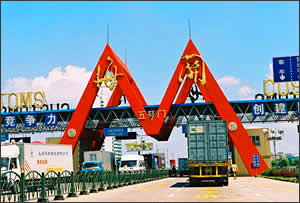Waigaoqiao Bonded Zone in Shanghai, the first of its kind in the country, is also the first trial area to become a free trade zone following approval from the State Council last year. Other trial areas include Yantian Bonded Zone in Shenzhen, Guangdong Province. The volume of freight handled by these two bonded zones tops 10 million containers every year.
Bonded zones are required initially to convert to free trade areas through their cooperation with nearby ports. Part of the ports will be used as extended logistics chains of bonded zones, where convenient transportation will help simplify goods distribution formalities and reduce enterprises' production costs.

On March 23, four companies moved to such areas of Shanghai's Waigaoqiao Bonded Zone to expand their businesses.
Ratcheting up to the level of free trade zone has become the goal for China's bonded zones and it is felt that now is the right time to begin the experiment. The country is expected to finish the trials by the end of 2006 and establish two or three world-class free trade zones by 2015, after necessary rounds of adjustment.
China began to set up bonded zones in 1990 and there are currently 15, including Shanghai's Waigaoqiao, Shenzhen's Futian and Shandong Province's Qingdao. By the end of 2002, the total area occupied by bonded zones was just a hair over 51 square km. Most of the bonded zones in China handle export processing, import and export, similar to those of areas for processing export products and economic and technological development zones.
Chinese laws stipulate that bonded zones are actually special areas established within the country and supervised by customs. International practice dictates that goods entering free trade zones are considered exports and would enjoy tax rebates, while in China's bonded zones, the goods that are taken into the bonded zones from outside are considered exports, but or eligible for tax rebates only after the goods leave China.
Internationally, a free trade zone also offers financial and logistics services. In China, a bonded zone is not allowed to provide offshore market business, and logistics services such as storage, distribution and transportation are not fully developed. The thorniest problem in logistics is the separation of bonded zones from ports, which means goods cannot move directly from ports to bonded zones since they have to go through customs inspections of both.
Free trade zones are more extensive and flexible than bonded areas in terms of both area and functions. A free trade zone within a country refers to a duty-free area without trade restrictions or customs administration.
The other important preferential policy enjoyed previously by enterprises inside bonded zones was that goods from outside the zones but within the Chinese mainland were considered exports and eligible for tax rebate. But since China has reduced the export tax rebate rate this year, bonded zones have lost much of their significance.
By 2006, China's tariffs will be cut by a large margin according to WTO agreements, and non-tariff barriers of bonded zones would be gradually removed. By then, companies engaged in trade inside bonded zones--about 80 percent of all registered companies--might choose to move on.
Liu Shouliang, manager of a company in Qingdao Bonded Zone, said bonded zones would lose their attractiveness if they were deprived of policy advantages.
"If not adaptive to the new situation, bonded zones will cease to exist in all but name," said Liu.
Meanwhile, bureaucracy and poor supervision by customs have become common complaints in the zones. A company official of a bonded zone in Shanghai said customs was incredibly inefficient, and sometimes a single job can drag on for one to two months.
Industrial insiders said China would adopt more open policies after bonded zones undergo their transformation, such as import and export protective tariffs, duty- and certificate-free. Companies can take full advantage of these policies to optimize export structure, update and upgrade products and enhance their competitiveness so as to realize a balance of international payments and increase foreign exchange reserves.
Cheng Siwei, vice chairman of the Standing Committee of the National People's Congress, said that although free trade zones could also serve for transit trade, export trade, commercial exhibition and product processing, their main function was logistics, not simply export transportation.
Cheng hoped that the conversion of bonded zones to free trade zones will attract more foreign freight to Shanghai and Shenzhen, and that multinationals will establish logistics or distribution centers in free trade zones.
Some analysts believe that it is unnecessary to transform all 15 bonded zones into free trade zones, and that limited trials should be held. They said that three to four free trade zones are enough for China, and other bonded zones could become special or exclusive import and export processing areas or other types of open zones.
Wei Bingyi, head of the Qingdao Productivity Association, believes that the smooth transformation from bonded to free trade zones can be realized through integration with ports, which means that the bonded zone's area would extend to an entire port. After conversion into free trade zones, goods could enter into direct processing, storage and trade after discharge, saving time in customs inspections.
All is well so far for the trial reform at Shanghai's Waigaoqiao Bonded Zone. Gong Zheng, deputy director of the General Administration of Customs, said Waigaoqiao's transformation is not only a trial, but also an important breakthrough.
All good things must come to an end, and the time for bonded zones is over. Only by metamorphosing into free trade zones will the bonded zones fly higher.
(Beijing Review April 8, 2004)

